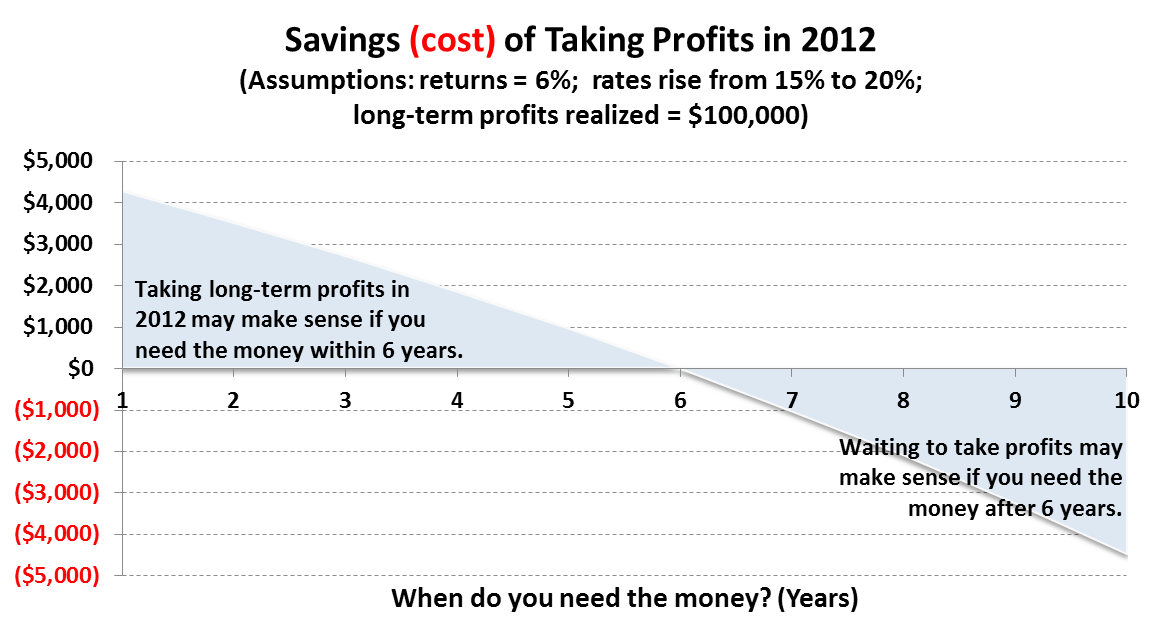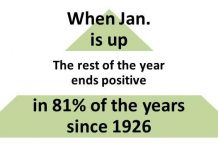 “What is one really trying to do in the investment world? Not pay the least taxes, although that may be a factor to be considered in achieving the end. Means and end should not be confused, however, and the end is to come away with the largest after-tax rate of compound.”
“What is one really trying to do in the investment world? Not pay the least taxes, although that may be a factor to be considered in achieving the end. Means and end should not be confused, however, and the end is to come away with the largest after-tax rate of compound.”
— Warren Buffett
Without legislative action in the waning days of 2012, next year’s maximum long-term capital gains tax rate will rise from 15% to 20%. This means, for example, selling an investment with accumulated long-term capital gains of $100,000 will generate taxes of $15,000 in 2012. Beginning January 1, the same sale will cost $20,000 in taxes. Happy New Year.
At first glance, you may be wondering whether you should be hurriedly selling appreciated holdings, taking advantage of this year’s lower rate. As is often the case, the correct answer isn’t always the most obvious one. Weighing numerous “tug of war” factors requires you to consider your unique personal circumstances as well as the larger world of possibilities yet to play out.
The bigger picture:
No one knows the outcome of the legislative process. Current long-term capital gains rates may remain the same, increase only for the wealthy, or go up for everyone. For sure, various tax increases and spending cuts seem inevitable given the nation’s need to reduce its debt, but we can currently only speculate on how these changes take place. The best investment decisions are the ones we can base on facts, not guesswork.
Your view of the world:
There could be any number of reasons that trump immediate tax-management concerns. For example, if you intend to pass the lion’s share of your unspent estate through to your beneficiaries, you may be able to reset your long-term capital gains to zero at that time (assuming proper planning and execution by a tax specialist well-versed in the latest, ever-evolving estate planning laws). So,generally, avoiding the realization of gains now could save money in the long-run.
Given these two points, here are my recommended rules of thumb:
- If you need the money now or in a foreseeable future – then it makes sense to consider whether to harvest the gains now or in the future.
- If you have no need to spend the assets – why try to react to an unknowable future? There are no guarantees, but remaining invested in our capital markets seems to offer the best odds for sustaining or building wealth according to your personal goals and risk tolerances.
The Math: A tug of war between compounding capital gains versus 2012’s lower rates
Let’s assume our first rule of thumb applies, and you do have upcoming spending needs to plan for. Deciding whether to take gains this year or in the future can be simplified by three interacting factors:
- Investment returns (the growth of future capital gains). Higher growth favors not taking profits, all else equal. Why? By not taking profits, your investment base remains larger and compounds more than a base made smaller by taking profits that generate taxes and reduce your investment base.
- The amount capital gains tax rates increase. The higher the increase, the more likely it will make sense to take profits sooner. Why? Compounding only goes so far. A large tax increase is difficult to offset with compounding. In addition, for some, next year’s capital gains rates could be as high as 23.8% due to the new 3.8% Medicare surtax.
- When you need the money. The sooner you need the money, the more likely it will make sense to take profits (realize capital gains) in 2012, all else equal.
The graph below illustrates this final point for a given capital gains tax increase and investing return.

Reading the chart:
From left to right, your savings gradually decline over time for taking gains in 2012 (reinvesting the amount that isn’t spent on taxes until you need to spend it).
- One year out – If you need the entire $100,000 one year from now, taking the gain, paying the tax and reinvesting the balance saves about $4,000 over simply holding the investment.
- Six years out – Taking profits in 2012 and reinvesting produces the same result as simply holding your investment.
- 10 years out – If you will not need your investment for 10 years, taking gains this year will cost you about $4,500.
It is important to emphasize the illustration above is based on best assumptions of future returns and capital gain rates, which of course are unknowable. A chart at the bottom of this post illustrates the impact of a tax rate increase from 15% to 23.8%. Combined, these charts are meant more to demonstrate the thought process we help take clients through in their planning than to serve as an absolute guide.
Takeaway:
When you need to plan for spendable assets, deciding whether to take profits in 2012 or in the future depends on many factors: some you know and some you don’t. After you and your advisor have weighed them all, if it makes good sense for you to realize capital gains in the context of your particular bigger-picture financial plan, then by all means, now might be a good time to do so. However, don’t rush out to take gains just for the sake of taking gains in the absence of a larger plan. Instead, if you do not yet have a good plan in place, you will do yourself a far greater favor in the long run to use the rest of 2012 to take the time to build one.
Addendum: The Impact of a 23.8% tax
Read more on Capital Gain
These statements are based on assumptions that may involve known and unknown risks and uncertainties. Past performance is not indicative of future results and no representation is made that the stated results will be replicated. Indexes are not available for direct investment but reveal positive and negative performance over time. Their performance does not reflect the expenses associated with the management of an actual portfolio. Diversification does not ensure a profit or protect against a loss in a declining market.
Copyright © 2012, Granite Hill Capital Management, LLC.
This blog entry is distributed for educational purposes and should not be considered investment, financial, or tax advice. Investment decisions should be based on your personal financial situation. Statements of future expectations, estimates or projections, and other forward-looking statements are based on available information believed to be reliable, but the accuracy of such information cannot be guaranteed. These statements are based on assumptions that may involve known and unknown risks and uncertainties. Past performance is not indicative of future results and no representation is made that any stated results will be replicated. Indexes are not available for direct investment. Their performance does not reflect the expenses associated with the management of an actual portfolio.
Links to third-party websites are provided as a convenience and do not imply an affiliation, endorsement, approval, verification or monitoring by Granite Hill Capital Management, LLC of any information contained therein. The terms, conditions and privacy policy of linked third-party sites may differ from those of this website.





